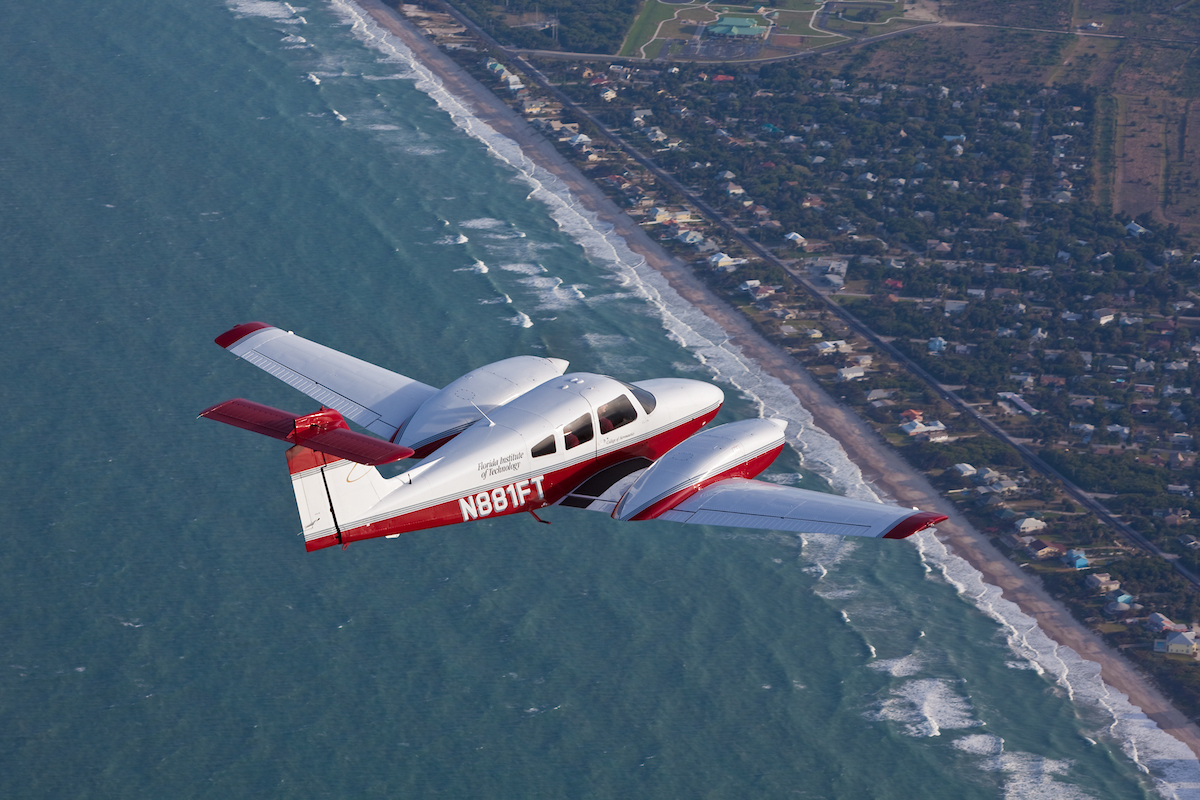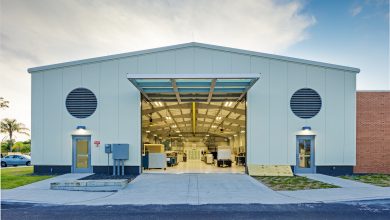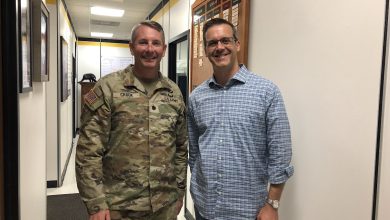Connecting Flights: COA Alumni Share Their Paths to Careers at the FAA
Though they may seem like simply a mile or two of thick asphalt, runways at major airports are extremely complex endeavors. Factors include the proposed runway’s proximity to existing runways (and the planes on them), where it would lie in relation to the terminal building, awareness of windspeed and direction, and the types of aircraft it will welcome—the bigger the plane, the longer the runway would need to be. There are simulation models and input from many voices, from the FAA to airlines to local airport authorities and the consultants they hire. It’s no surprise that building a new runway can take nearly a decade, including several years for planning alone.
“If you put a billion and a half dollars in the ground, you need it to work the way it is expected to,” says Kent Duffy ’98, operations research analyst at the FAA’s Airports Planning Branch.
Duffy and three other Florida Tech alumni—Rebecca Didio ’07, Christina Nutting ’07 and Mike Hines ’87—all in the FAA’s Airport Planning & Programming Office (APP), Planning and Environmental Division, are helping to plan for future needs like this and for the overall management and development of more than just runways. Based at FAA headquarters in Washington, D.C., division personnel provide guidance and assistance on airport master planning and infrastructure layout, capacity, airspace and system plans as well as aviation forecasts.
“With airports, there is always something that needs to be built or improved,” Duffy says. “It’s never boring.”
Exactly how four Panthers came to work at the same office in the sprawling, 45,000-employee FAA provides insight into how to successfully build an aviation career that leads to employment at the largest transportation agency of the U.S. government.
HERE ARE THEIR STORIES.
Rebecca Didio ’07

Rebecca Didio ’07, an airport planning specialist for the Planning and Environmental Division in APP, was interested in aviation early on. She took an aeronautics elective in high school that she enjoyed, and as she researched possible careers, Didio gravitated further toward aviation and the notion of becoming a commercial pilot.
At Florida Tech, she began majoring in aeronautical science with flight but switched to aviation management with flight in her second semester, a move that made more and more sense as it became clear that pilot demand would be waning as the early 2000s recession took hold. Her new major allowed Didio to explore planning and design while still completing her flight training to become an instrument-rated commercial pilot for single and multiengine land aircraft.
“The aviation management degree offers a broad range of courses that cover a lot of aspects of the aviation industry,” Didio says.
After graduation, she began what is a fairly common career trajectory: building experience through consulting. She went to work as an aviation planner for Leo A Daly, a design and consulting firm in Honolulu, where she worked on airports at island nations throughout the South Pacific. After two years, she moved on to work for C&S Cos., also a consultancy. There, she focused mainly on smaller and general aviation airports in the Northeast and strengthened her skills as a planner while also taking on project management responsibilities. After about four years at C&S, Didio was hired at AECOM, a large multinational engineering firm that allowed her to work on projects at far larger airports than she did at C&S.
In 2016, Didio saw an FAA job listing that her fellow Panther and soon-to-be colleague Duffy posted on the Florida Tech College of Aeronautics Alumni Association Facebook group.
“I wasn’t looking for a new job, but I saw the post and said, ‘Oh, this is kind of right up my alley,’ and I applied for it.”
Didio reached out to another Panther at the FAA: Nutting, an airport planning specialist in the Planning and Environmental Division and Didio’s longtime friend who had graduated from Florida Tech the same year she did. Nutting told her about the job, the various projects they were working on and what the hiring process was like.
“She was really helpful in preparing me for what to expect,” Didio says.
Didio was hired that year and soon found herself a colleague to Duffy, Nutting and Hines, the manager.
Advice to Students:
Aviation in general is a very close-knit industry. Planning and consulting is even smaller. One of the most valuable skills in this industry is networking. It has been absolutely invaluable for me. My job at AECOM, I got it because another alumni worked there, and I was able to send him my resume.
For my FAA office specifically, just building up your skills in airport planning. We have offices throughout the country—field offices are good places for new grads with little or no experience. Headquarters is for higher-level, running national programs, and requires higher levels of experience.”
REBECCA DIDIO ’07
Christina Nutting ’07

Christina Nutting ’07 planned to become a commercial airline pilot after high school. She was accepted into several schools, including Florida Tech and a few in colder climates. Impressed by Florida Tech’s flight program and drawn to the Sunshine State’s warmer temperatures, she started at Florida Tech in 2004. She entered with some advice from her mom: Rather than going just to become a pilot, consider getting an aviation-related degree, as well, “to have a backup if you ever need one.”
It was timely advice. After about a year of flying, Nutting shifted her focus fully to aviation management. As many did after graduation, she went into consulting. She started at URS Corp., working with another College of Aeronautics grad, Don Scata ’03, and then returned to school to earn an MBA with an airport management specialization. A few years later, in 2012, Scata contacted Nutting and asked if she was interested in working at the consulting powerhouse Booz Allen Hamilton, where he worked. She took the job.
Later, Scata left for the FAA, and soon, so did Nutting. She came aboard as an airport planning specialist in 2014.
“It’s kind of neat how the connections you make, even starting in college, will really lead to different windows or opportunities down the road,” she says.
Advice to Students:
Be open to different experiences. In the FAA, there are opportunities to do details in different offices or divisions or around the country—make sure you take those. Take the opportunity to learn and see if that will open the door to somewhere else. The more you get involved in other areas, the more it helps you at your own job connect the pieces and see how they might fit together.”
Christina Nutting ’07
Mike Hines ’87
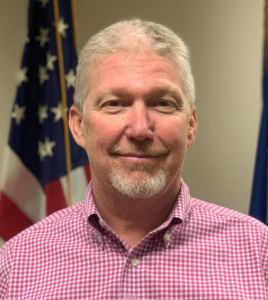
Mike Hines ’87 discovered aviation at a college fair in his native Virginia. He then enrolled at a West Virginia university to learn to fly. That wasn’t a good fit, so he moved home and began flying at his local general aviation airports while he sought a better fit for his education, ultimately opting for Florida Tech over Embry Riddle Aeronautical University.
He earned his pilot’s license in his first semester, but he eventually pivoted to aviation management/ flight technology, dropping the flight training after his freshman year. One of his favorite classes was airport planning and design, and when a representative from HNTB was on campus interviewing for an airport planning position, Hines was interviewed. A few weeks after graduation, he got the call: He was offered a position as an airport planner in the firm’s Miami office.
Hines was at HNTB for 20 years. In 1994, after eight years in Miami, he was asked if he wanted to move back to his home state to work at the U.S. Army Aviation Center of Excellence in Alexandria, Virginia. There, he worked on master planning and facility planning with many of the country’s largest airports.
In 2008, with experience consulting on Washington’s airports, Hines went to work for the Metropolitan Washington Airports Authority as an airfield and airspace planner. He spent eight years there, departing as manager of the Airport Planning Division under the Office of Engineering to take on his first federal job—with the FAA.
It all started, Hines says, in sunny Melbourne.
“Florida Tech opened the door. Without Florida Tech, without that interview on campus, I would never have had the opportunity.”
Advice to Students:
Take opportunities, take chances, take risks. Maybe you’re not interested, but go do it—you never know what you’ll find. Don’t be afraid, and don’t quit. Also, take pride in what you do. If you are there to collect a paycheck, find something you’d like to do. Being a little persistent—don’t be a pest, but don’t be afraid to be persistent, to look for opportunities. Don’t be afraid to network; that can be huge. And be careful about your reputation. Be careful what you put on social media. The FAA doesn’t do it so much, but private corporations are viewing social media from folks they are about to hire.
Mike Hines ’87
Kent Duffy ’98
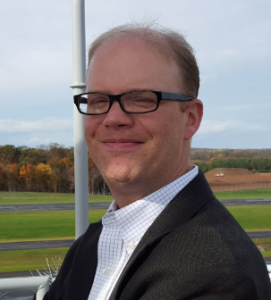
Kent Duffy ’98 came to Florida Tech from Pittsburgh, toting an interest in aviation that started young. By age 15, he was taking flight lessons. His high school had a STEM focus, so that mingled with his growing passion for aviation.
“I didn’t know what I wanted to do with that, but it was an interesting pairing,” he says. “So I started looking at colleges.”
His visit to Florida Tech’s Melbourne campus was a good experience. Duffy felt a connection, he says. He enrolled, majoring in aeronautical science with flight. The results? “A really solid multidisciplinary aviation education.”
He interned with American Airlines his junior year and spent three years as a resident assistant (RA), a deeply impactful experience.
“That was really just a great way to learn people skills, meet a lot of people I didn’t know—interesting, diverse people,” Duffy says. “The technical education, that was foundational. But the experience from being an RA was really huge—almost equal, in a way, just for the life-lesson aspects, if you will.”
An alumni connection hatched during an end-of-year hangar party landed Duffy his first post-college job at engineering and consulting firm HNTB Corp. He did technical work related to airport planning and environmental permitting, and he learned a lot, he says.
In 2006, a friend alerted Duffy to a job at Booz Allen Hamilton, and with an opportunity to learn management consulting—as opposed to the engineering consulting he did at HNTB—he applied and was hired.
In 2009, Duffy joined the FAA as an airport planner. He worked on the Nextgen program, applying his data analytics skills to technical airport planning: airport capacity, getting runways the right length, integrating with air traffic control. Six years later, he was promoted to handle even more complex problems as an operations research analyst.
A throughline in Duffy’s career, he says, is something that cannot necessarily be taught: curiosity. It has spurred him to take on a range of projects and brought lasting value to interactions with others.
“In the FAA, I spent time with people with different skill sets—air carrier pilots who work in flight standards, say—because they have a different knowledge base than I do, and they always have things you can learn from,” he says. “It’s really important to be curious.”
Advice to Students:
One of the attributes of the FAA is there are so many different skill sets—geographers, pilots, human factors, people who are data scientists. So if you have a technical skill set, it’s a really interesting place to work. For my career, it was great to come out of school and spend some time in private enterprise. It’s a great learning laboratory. Then, at certain point, maybe midcareer, you’re starting to ask, ‘I want to understand how these other things work. I want to do the tough work of trying to make X, Y, Z better.’ That is a great rationale to try to come into the FAA.
Kent Duffy ’98
This piece was featured in the spring 2022 edition of Florida Tech Magazine.

